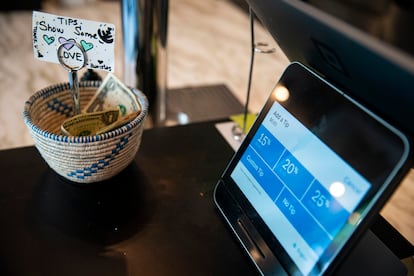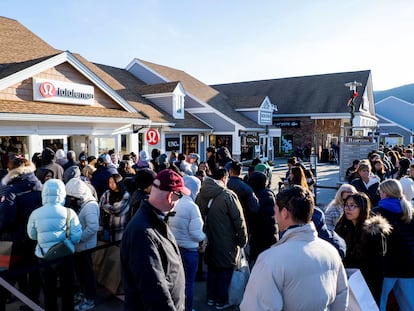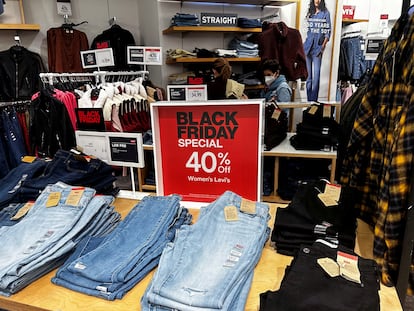Tips are baffling Americans
Consumers feel that they are increasingly being asked to pay extra for more services and are unclear when and how much to pay


Tipping is experienced very differently throughout the world. In Japan, it can be insulting, because good service is considered a duty that comes with the salary. In Europe, tipping tends to be associated with appreciation for good hospitality and, in any case, is relatively low. In the United States, however, they are practically a must, as they constitute a substantial part of the compensation of employees in hospitality and other industries. The general impression among Americans is that the obligation is gaining more and more ground and consumers are increasingly clueless about how much to tip and when.
The practice of tipping has its roots in 16th century England and until the 19th century was more common in Europe than in the United States. But the tables were turned to such an extent that in the early 20th century waiters in fashionable restaurants in the United States had to pay the owner to work there (and thereby collect tips). Reprisals against customers who did not loosen their pockets were varied, and in Chicago the police even dismantled a network that poisoned those who did not leave a tip.
Unwritten rules generate legal uncertainty. In the absence of laws, custom prevails, but when customs are in flux, trouble is guaranteed. A report released last month by the Pew Research Center shows that only one-third say it is very easy to know whether to tip (34%) or how much (33%) for different types of services, according to the results of a macro survey of 11,945 people.
There is also no consensus on whether tipping — which is embedded in the wage structures and business models of many service sectors — is more of a choice or an obligation for consumers. About two in ten Americans (21%) say it is more of a choice, while 29% say it is more of an obligation. The largest proportion (49%) say it depends on the situation, underscoring the lack of a single set of rules or expectations.
What the majority (72%) do agree on is that they find themselves being asked for tips in an increasing number of places, in a phenomenon dubbed tipflation and spurred in part by the pandemic. While in countries with less established tipping traditions, such as Spain, the decline in cash payments has affected tipping, in the United States it has found a breeding ground in which to reproduce. Suggested tipping screens are multiplying and appearing everywhere: fast food chains, self-service stores, drive-through car washes and even in some merchandise stores. Even robots, like a milkshake maker in San Francisco, want your tip.
Restaurants with full table service continue to be the kings of tipping. About nine in ten adults who eat there (92%) say they always or often tip. Compensation of 15% is considered the minimum acceptable and 18% or 20% is more common, although the conclusions depend very much on the guidebook consulted.
Beyond restaurants, tipping is also very common when getting a haircut (78%), for home food delivery (76%), ordering a drink at a bar (70%) or using a cab or ride-sharing service (61%). In contrast, few Americans tip always or often when buying a coffee (25%) or eating at a fast-food restaurant (12%), but payment screens suggest doing so increasingly often.
To complicate matters further, in more and more restaurants in large cities like New York or Washington, the bill comes with a surcharge or service charge (kept by the owners) to which taxes and also the tip (which by law goes to the waiters) must be added. Restaurants justify it due to inflation and laws that have been demanding better pay for waiters. Some of them argue that they charge a surcharge so they don’t have to raise prices. How considerate of them! They deserve a tip.
Sign up for our weekly newsletter to get more English-language news coverage from EL PAÍS USA Edition
Tu suscripción se está usando en otro dispositivo
¿Quieres añadir otro usuario a tu suscripción?
Si continúas leyendo en este dispositivo, no se podrá leer en el otro.
FlechaTu suscripción se está usando en otro dispositivo y solo puedes acceder a EL PAÍS desde un dispositivo a la vez.
Si quieres compartir tu cuenta, cambia tu suscripción a la modalidad Premium, así podrás añadir otro usuario. Cada uno accederá con su propia cuenta de email, lo que os permitirá personalizar vuestra experiencia en EL PAÍS.
¿Tienes una suscripción de empresa? Accede aquí para contratar más cuentas.
En el caso de no saber quién está usando tu cuenta, te recomendamos cambiar tu contraseña aquí.
Si decides continuar compartiendo tu cuenta, este mensaje se mostrará en tu dispositivo y en el de la otra persona que está usando tu cuenta de forma indefinida, afectando a tu experiencia de lectura. Puedes consultar aquí los términos y condiciones de la suscripción digital.
More information
Archived In
Últimas noticias
Most viewed
- Sinaloa Cartel war is taking its toll on Los Chapitos
- Oona Chaplin: ‘I told James Cameron that I was living in a treehouse and starting a permaculture project with a friend’
- Reinhard Genzel, Nobel laureate in physics: ‘One-minute videos will never give you the truth’
- Why the price of coffee has skyrocketed: from Brazilian plantations to specialty coffee houses
- Silver prices are going crazy: This is what’s fueling the rally










































